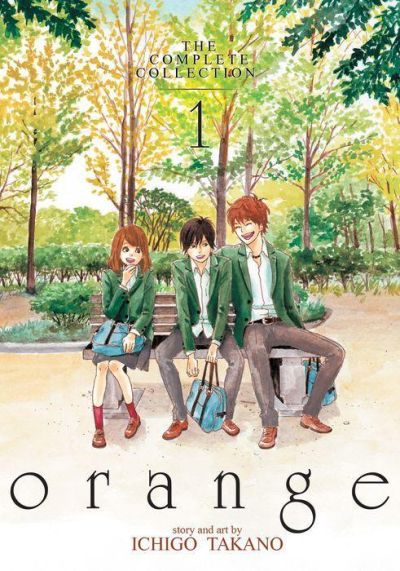The Only Light We’ll See
orange
By Ichigo Takano

30 Mar, 2022
0 comments
Ichigo Takano’s time-travel manga series orange was first serialized in 2012 in Bessatsu Margaret manga magazine; it later appeared in Monthly Action. US editions were published in 2016.
Uncharacteristically late for school, Naho Takamiya defers reading the letter she received that morning. When she does read it, the contents are astonishing. The writer predicts that Naho will have slept in. They go on to inform Naho that there will be a new transfer student and that despite Naho’s comradely instincts, she and her friends (Takako Chino, Saku Hagita, Azusa Murasaka, and Hiroto Suwa) should not invite the stranger to accompany them that day.
Most astonishingly, the writer claims to be Naho herself, writing ten years in the future.
As many people might, Naho ignores the advice. Tragedy ensues.
Kakeru Naruse seemingly enjoys his outing with his new friends. Nevertheless, he skips the next two weeks of school. When he does return, he avoids answering when his schoolmates ask about his absence.
Letters from the future continue to arrive. In them, the Naho of the future explains that her purpose is to spare her past self the regrets that haunt the older Naho. Many of those regrets involve Kakeru, ten years dead at the time the future Naho is writing letters.
Despite their close friendship with Kakeru, young Naho and her friends fail to grasp the depth of his despair. They discover the truth (Kakeru’s death was not a traffic accident, but suicide) only after their friend has been dead a decade. Nothing can be done for him … now. But if there were a way to send letters to the past, perhaps a new history could be written.
Cue a delivery of letters to the mid-Atlantic black hole, which thanks to an impromptu lecture about time travel in high school, Kakeru’s friends know how to exploit.
The first crisis point has passed. While Kakeru was having fun with his new friends, his mother killed herself, believing her son would be better off without her. The trauma will mark Kakeru for life. However, thanks to the letters, Naho has foreknowledge of what is to come. So do her friends. Together, they will do their best to save Kakeru.
Can the future be changed or will it drift back to the known path? And if the future is changed, won’t the letters cease to be useful guides to the future? Kakeru’s life depends on those answers.
~oOo~
Ichigo Takano’s art is professional enough, but perhaps unrealistic: all of her characters are attractive, even the ones who are supposed to be somewhat plain. Takano resorts to simply asserting that Naho, who looks much the same as the other girls in her class, is not as pretty.
Every SFF author gets their gimme. In the case of orange, that gimme involves group projects. Of course, in the real world, once academic group projects grow past a certain point (and with five students, Naho and her friends are past that point), every group project has its slackers who do not do their share and others whose contributions make matters worse. Astonishingly, the teens manage to avoid both pitfalls. All are eager participants, and none of them are fuckups. Implausible, but readers are best advised to accept the contrafactual and move on.
Time travel stories need to pass the Bill and Ted test: anyone who cannot use time travel (or time communication in this case) at least as well as Bill and Ted have no business dabbling in time travel. Takano’s orange passes the test: thanks to that terribly convenient lecture in high school, the characters are very well informed about causality and cosmology as they apply to time communication. This is a setting that embraces many worlds. The letters cannot save the older Naho’s friend Kakeru. That past has been lived and cannot be rewritten. Instead, the letters might create a branch in which another Kakeru lives. It’s a bittersweet consolation but better than nothing.
Saving the incredibly depressed Kakeru is inherently tricky, as he is inclined to see every setback as his fault and interpret everything that happens to him as evidence the world would be better off without him. This is of course the same logic his mother used, but he cannot generalize from that experience to see that he might be wrong. He’s depressed and his brain is lying to him.
Luckily for Kakeru, his friends are willing to make enormous sacrifices for him. It would have been even better if at any point poor Kakeru were to have gone into therapy and if appropriate taken medication … but perhaps that wasn’t a realistic option in that time and place.
Readers looking for a multivolume feel-good experience about supportive friends may enjoy this story. I know I ended up bingeing the series.
Volume One of orange is available here (Amazon US), here (Amazon Canada), here (Amazon UK), here (Barnes & Noble), here (Book Depository), and here (Chapters-Indigo). Presumably the other volumes are nearby.
